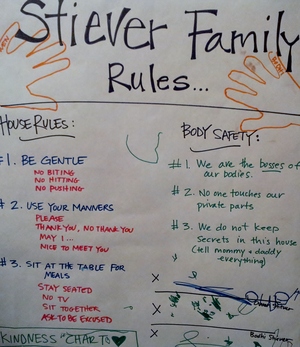It’s
the holiday season. Let’s talk prevention! Here are three specific
suggestions for making child sexual abuse prevention a conversation
topic with friends and family during your holiday.

- Invite friends and family into a
conversation about keeping kids safe from child sexual abuse. Each
person has his or her own communication style, but here are a couple of
ice-breakers to consider:
- Let people know you went to a Parenting Safe Children workshop and why you’ve decided to invite all of the adults in your child’s life onto your prevention team.
- Hang your body safety-rules poster in a prominent location, like the Stiever Family poster to the right, and let your family members and friends know about the rules and why they are important.
- Consider giving a friend or family member Off Limits: A Parent’s Guide to Keeping Kids Safe from Sexual Abuse, with a personal inscription about why it’s important to you.
- Bring up body safety just as you would any other safety topic – e.g. “I’m so glad you got a car seat with all those safety components. Can I tell you about our latest safety measure?”
You probably have other ideas for, and success stories about, inviting people onto your prevention team. Please share them on Facebook so we can all learn together.
- As children go off to play, remind both the children and the adults about your family’s four body-safety practices:
- Everyone plays with their clothes on.
- No one touches private parts.
- We don’t keep secrets.
- If you feel unsafe in any way, come tell a trusted adult.
- The holidays are a time of greetings and affection, so it’s particularly important to remember that children and teens are safer when they get to choose when and with whom to show affection. If a family member or friend wants to greet your child with a hug or kiss, and your child does not want to, then you are being presented with a wonderful teachable moment and an opportunity to stand up for your child.
Mom or Dad: “I know you’re a hugger Mom, but we’ve taught Ben that he gets to choose when he shows affection and it looks like he doesn’t want to hug right now.”






